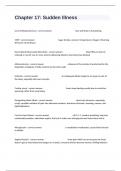Chapter 17: Sudden Illness
Level of Responsiveness - correct answer how well brain is functioning
STOP - correct answer Sugar (stroke, seizure), Temperature, Oxygen, Poisoning
(Pressure on the Brain)
Heart Attack (Myocardial Infarction) - correct answer blood flow to heart is
reduced or cut off; one or more arteries delivering blood to heart becomes blocked
Atherosclerosis - correct answer a disease of the arteries characterized by the
deposition of plaques of fatty material on the inner walls
Ischemia - correct answer an inadequate blood supply to an organ or part of
the body, especially the heart muscles
Cardiac arrest - correct answer heart stops beating usually due to ventricles
quivering rather than contracting
Recognizing Heart Attack - correct answer chest pain (pressure, squeezing,
crush), possible radiation of pain into alternate locations, shortness of breath, sweating, nausea, and
lightheadedness
Care for Heart Attack - correct answer call 9-1-1, monitor breathing, help into
comfortable position, administer aspirin, find out if victim uses nitroglycerin and assist them with it
Nitroglycerin - correct answer a vasodialator medication; causes blood vessels
to dialate
Angina Pectoris - correct answer chest pain which occurs because the heart
doesn't get as much blood and oxygen as it needs. Coronary arteries become narrow, limiting blood to
, meet demands of physical exercise, excitement, emotional upset, eating of a heavy meal, extreme hot
and cold temperature exposure, cigarette smoking. Have victim sit down, administer prescribed
nitroglycerin.
Stroke (brain attack) - correct answer sudden interruption of blood flow to
brain due to arteries in the brain that rupture or become blocked; effects can be permanent
Transient Ischemic Attack (TIA) - correct answer mini stroke
Ischemic Stroke - correct answer blood vessels become narrowed, clogged
with plaque or blood (85%)
Hemorrhagic Stroke - correct answer blood vessel ruptures in or near the brain
(15%)
Recognizing Stroke - correct answer weakness, numbness, paralysis of face or
one side of the body, blurred or decreased vision, slurred speech, dizziness or loss of balance, sudden
severe, unexplained headache, etc.
Care for Stroke - correct answer call 9-1-1, note time first signs appear,
monitor breathing, don't give them medication or anything by mouth, reassure victim and keep them
warm, if responsive place in comfortable position with head elevated, if unresponsive and breathing -
place in recovery position
Asthma - correct answer Chronic lung disease (reactive) that inflames and
narrows lower airways; causes recurring periods of wheezing, chest tightness, shortness of breath, and
coughing
Recognizing Asthma Attack - correct answer symptoms can range from mild to
severe; excessive coughing, wheezing, chest tightness, shortness of breath, sitting in tripod position
Care for Asthma Attack - correct answer place victim in comfortable position,
ask about medication (long term control vs. quick relief




